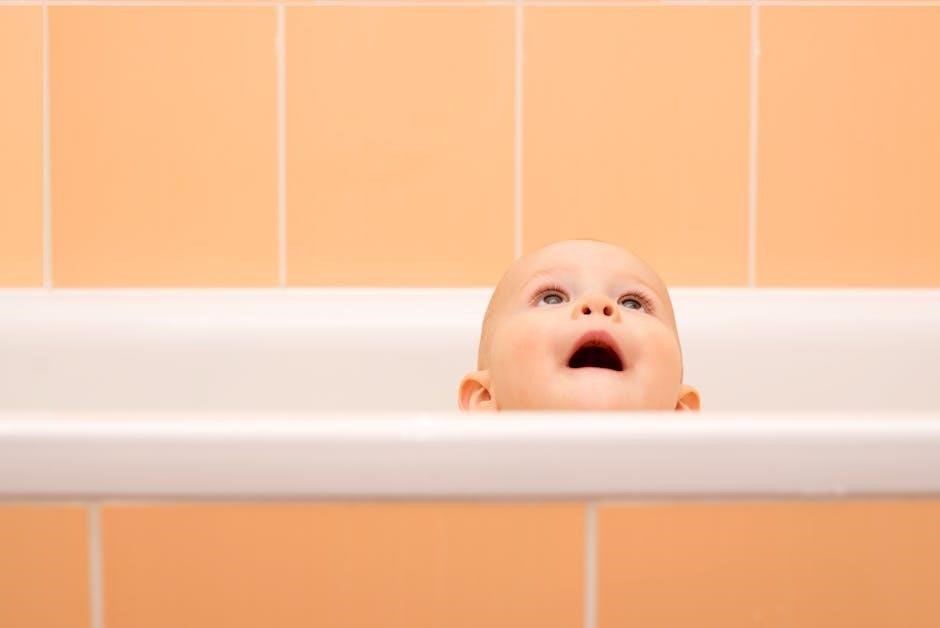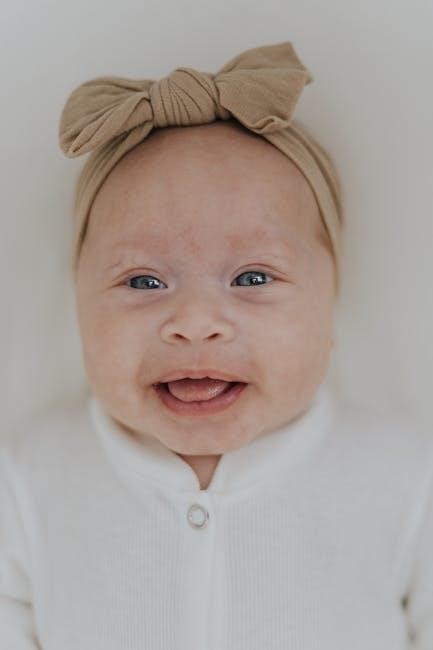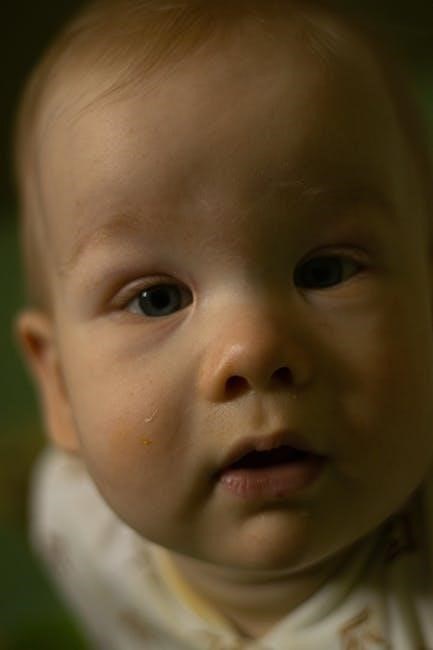Pediatric eye charts are essential tools for assessing children’s vision, using age-appropriate symbols or images to measure visual acuity effectively․ These charts differ from standard eye charts by incorporating child-friendly designs, such as pictures or letters, to engage young patients and ensure accurate results․ Regular use of pediatric eye charts helps detect vision problems early, monitor progress, and support overall developmental health in children․ They are widely used by optometrists, pediatricians, and even parents at home to promote early intervention and better eye care outcomes․
Overview of Pediatric Eye Charts
Pediatric eye charts are specialized tools designed to assess visual acuity in children․ These charts use child-friendly symbols, pictures, or letters to engage young patients and ensure accurate results․ They are tailored to meet the unique needs of children, making vision testing less intimidating and more effective․ Pediatric eye charts are commonly used in clinical settings, schools, and homes to detect vision problems early․ Regular use helps monitor visual development, identify potential issues, and ensure timely intervention․ Their design emphasizes simplicity and clarity, making them indispensable for promoting healthy vision in children and supporting their overall developmental growth․
Importance of Vision Testing in Children
Vision testing in children is crucial for identifying potential eye problems early, as untreated issues can impact learning, development, and overall quality of life․ Pediatric eye charts are designed to detect vision impairments, such as nearsightedness, farsightedness, or amblyopia, which can affect a child’s ability to read, write, and engage in daily activities․ Regular screenings help ensure timely intervention, preventing long-term vision loss․ Early detection also supports academic success, as clear vision is essential for classroom learning․ Parents and educators often use printable pediatric eye charts at home or in schools to monitor visual health and promote early care for developing eyes․

History of Eye Charts
Eye charts originated in the 1860s with the Snellen chart, revolutionizing vision testing․ Pediatric versions evolved later, incorporating symbols and pictures for child-friendly assessments, ensuring accurate results for young patients․
Development of the Snellen Eye Chart
The Snellen eye chart was developed in the 1860s by Dutch ophthalmologist Hermann Snellen, revolutionizing vision testing․ It introduced standardized optotypes—letters of varying sizes—to measure visual acuity accurately․ This chart became a cornerstone in ophthalmology, enabling consistent assessment of vision clarity․ Its design ensured uniformity, making it easier to compare results across different examinations․ The Snellen chart’s innovation laid the groundwork for modern vision testing tools, including pediatric-specific charts that adapt its principles for younger patients․ Over time, it has remained a fundamental tool in eye care, influencing the development of various eye charts tailored to different needs․
Evolution of Pediatric-Specific Eye Charts
The evolution of pediatric-specific eye charts began with the recognition that standard charts, like the Snellen chart, were not suitable for young children․ These early charts relied on letters, which pre-literate children couldn’t identify․ To address this, charts incorporating symbols like Lea Symbols, HOTV optotypes, and pictures were developed․ These designs made vision testing more accessible and engaging for children․ Over time, pediatric eye charts have become more refined, with digital versions and printable PDFs offering convenience for parents and professionals․ Their development has significantly improved early detection of vision issues, ensuring timely intervention and better outcomes for children’s eye health․

Types of Pediatric Eye Charts
Pediatric eye charts include Snellen charts adapted for children, Lea Symbols, HOTV optotype charts, and picture-based charts for pre-literate kids, ensuring age-appropriate vision assessment․
Snellen Eye Chart for Children
The Snellen eye chart for children is an adapted version of the standard Snellen chart, designed to measure visual acuity in pediatric patients․ It uses larger symbols or pictures, such as the “E” optotype, to make the test engaging and accessible for young children․ This chart helps assess distance vision and detect issues like nearsightedness or blurry vision․ Parents and professionals can use it at home or in clinics to screen for potential vision problems․ The chart is printed at full scale and placed 20 feet away, with the child identifying the direction of the “E” or other symbols․ Regular use aids in early detection of vision issues, ensuring timely intervention and better outcomes for children’s eye health․
Lea Symbols Chart
The Lea Symbols Chart is a widely used tool in pediatric vision testing, designed specifically for pre-literate children․ It features four simple shapes—a circle, square, diamond, and house—making it easy for young children to identify and engage with․ This chart is particularly useful for assessing visual acuity in children who cannot read letters; The symbols are arranged in decreasing sizes, similar to the Snellen chart, allowing for accurate measurement of vision clarity․ The Lea Symbols Chart is often preferred in clinical settings and at home for its effectiveness in evaluating children’s vision and detecting potential issues early․ Its simplicity ensures reliable results when used correctly․
HOTV Optotype Chart
The HOTV Optotype Chart is a popular tool for assessing visual acuity in children, utilizing four distinct symbols: H, O, T, and V․ These shapes are chosen for their simplicity and ease of recognition, making them ideal for pediatric use․ The chart is designed to measure how well a child can distinguish these symbols at varying distances, helping to identify vision problems early․ Unlike letter-based charts, the HOTV chart is particularly effective for pre-literate children or those with limited reading skills․ Its straightforward design ensures accurate and reliable results when administered correctly, making it a valuable resource for both clinical and home vision screenings․
Picture Eye Charts for Pre-Literate Children
Picture eye charts are specifically designed for pre-literate children, using colorful images instead of letters or numbers․ These charts feature familiar shapes or objects, such as animals, houses, or toys, to engage young patients and make vision testing fun․ They are particularly useful for assessing visual acuity in toddlers and preschoolers who cannot yet read or identify letters․ The images are arranged in decreasing sizes to measure how well a child can see at a standard distance․ This method ensures accurate results and makes the process less intimidating for children, promoting early detection of vision issues and supporting timely intervention․
Visual Acuity Measurement in Children
Measuring visual acuity in children is crucial for detecting vision problems early․ Pediatric eye charts use symbols or pictures to assess how well a child sees at various distances, ensuring timely intervention and proper eye care․
Understanding Visual Acuity Scores
Visual acuity scores, like 20/20, indicate how well a child sees compared to the standard․ The top number represents the distance (20 feet) from the chart, while the bottom reflects the size of objects seen clearly․ A lower second number (e․g․, 20/40) means larger objects are needed for clarity, suggesting reduced vision․ Pediatric eye charts use symbols or pictures to measure this in young children․ Understanding these scores helps identify vision problems early and guides corrective measures, ensuring proper eye development and addressing issues like nearsightedness or lazy eye effectively․
How to Interpret Pediatric Eye Chart Results
Interpreting pediatric eye chart results involves analyzing a child’s ability to identify symbols or letters at specific distances․ Each line on the chart represents a different visual acuity level, with the smallest line the child can read accurately determining their score․ For example, if a child correctly identifies most symbols on the 20/30 line, their visual acuity is recorded as 20/30․ Comparing results between both eyes helps detect discrepancies․ Significant differences may indicate vision problems like amblyopia or refractive errors․ Accurate interpretation ensures timely interventions, promoting healthy vision development in children․ Regular testing and professional evaluation are crucial for optimal outcomes․

Using a Pediatric Eye Chart at Home
Using a pediatric eye chart at home involves printing the chart, ensuring proper lighting, and maintaining the child’s focus․ Measure the distance accurately and test each eye separately to assess vision clarity and detect potential issues early․
Steps to Prepare and Use the Chart
Download and print the pediatric eye chart PDF at full scale without resizing․ Ensure the chart is clear and properly aligned․ Tape it to a wall at eye level, 20 feet away from the child․ Provide adequate lighting to avoid glare․ Have the child stand or sit comfortably at the correct distance․ Cover one eye and ask them to identify symbols or letters, moving down the chart until they struggle․ Test the other eye and compare results․ Maintain the child’s attention by using engaging instructions․ Document the smallest line they can read accurately and consult a professional if vision issues are suspected․
Conducting a Vision Test with Children
Begin by ensuring the child is comfortable and attentive․ Use the pediatric eye chart featuring child-friendly symbols or letters․ Cover one eye with an occluder or hand, starting from the top line․ Ask the child to identify each symbol or letter, moving downward until they struggle․ Note the smallest line they can read accurately․ Repeat with the other eye, comparing results․ For pre-literate children, use pictures or simple shapes to maintain engagement․ Keep the test brief and fun to avoid losing their interest․ Accurately document findings to share with eye care professionals for further evaluation if needed․

Benefits of Regular Vision Screening
Regular vision screening detects issues early, supports a child’s development, and enables timely intervention, ensuring optimal eye health and academic success․
Early Detection of Vision Problems
Pediatric eye charts play a crucial role in identifying vision issues early, ensuring timely intervention․ Conditions like myopia, hyperopia, astigmatism, and amblyopia can be detected through regular screening․ Early detection prevents severe vision impairment and supports healthy eye development․ Charts designed for children, such as those using symbols or pictures, make it easier to assess visual acuity in pre-literate or young patients․ By addressing problems early, treatments like glasses or therapy can significantly improve outcomes․ Regular use of these charts by parents and educators helps monitor a child’s vision, promoting better academic and developmental success․ Early detection is key to maintaining lifelong eye health․
Monitoring Progress in Vision Correction
Pediatric eye charts are invaluable for tracking progress in vision correction, ensuring treatments like glasses or therapy are effective․ Regular assessments using these charts help identify improvements in visual acuity over time․ By consistently monitoring a child’s vision, parents and eye care professionals can adjust corrective measures as needed․ The charts provide a clear, measurable way to observe how well a child is responding to treatment․ This ongoing monitoring supports optimal visual development and ensures interventions remain effective․ Regular use of pediatric eye charts fosters better outcomes and helps maintain healthy vision throughout childhood and beyond․
Impact on Learning and Development
Vision plays a critical role in a child’s learning and development․ Untreated vision problems can hinder reading skills, academic performance, and overall growth․ Pediatric eye charts help identify issues early, ensuring timely intervention to prevent developmental delays․ Clear vision is essential for tasks like recognizing shapes, colors, and letters, which are foundational for learning․ Poor vision can lead to struggles in school, affecting a child’s confidence and social interactions․ Early detection and correction of vision problems are vital to support healthy cognitive, emotional, and physical development, ensuring children reach their full potential in all areas of life․ Regular vision screening is key to fostering lifelong success․

Common Vision Issues in Children
Children often experience vision problems like myopia (nearsightedness), hyperopia (farsightedness), astigmatism, and amblyopia (lazy eye)․ Pediatric eye charts help identify these issues early, ensuring proper intervention for healthy vision development․
Nearsightedness (Myopia)
Nearsightedness, or myopia, is a common vision issue in children where distant objects appear blurry while close-up objects are seen clearly․ It occurs when the eyeball is slightly elongated or the cornea is too curved, causing light to focus in front of the retina․ Symptoms include squinting, headaches, and difficulty seeing distant objects․ Pediatric eye charts are effective in detecting myopia, as they measure visual acuity and identify blurred distance vision․ Early detection is crucial, as untreated myopia can progress and lead to more severe vision problems․ Regular vision screenings using pediatric eye charts help ensure timely intervention and proper corrective measures for children․
Farsightedness (Hyperopia)
Farsightedness, or hyperopia, is a vision condition where close objects appear blurry while distant objects are seen more clearly․ It occurs when the eyeball is shorter or the cornea is less curved, causing light to focus behind the retina․ Symptoms include difficulty with reading, eye strain, and headaches․ Pediatric eye charts are valuable tools for detecting hyperopia, as they assess visual acuity and identify struggles with near vision․ Early diagnosis is crucial, as untreated hyperopia can hinder a child’s learning and daily activities․ Regular vision screenings using pediatric eye charts help ensure timely intervention and appropriate corrective measures․
Astigmatism
Astigmatism is a common vision condition caused by an irregularly shaped cornea or lens, leading to blurred or distorted vision at all distances․ Children with astigmatism may struggle to see both near and far objects clearly․ Pediatric eye charts, such as the Lea Symbols Chart or HOTV Optotype Chart, are effective tools for detecting astigmatism․ These charts use symbols or letters to assess visual acuity and identify irregularities in how the eyes focus light․ Early detection is crucial, as untreated astigmatism can hinder a child’s academic performance and daily activities․ Regular vision screenings with age-appropriate charts help ensure timely intervention and corrective measures․
Lazy Eye (Amblyopia)
Amblyopia, or “lazy eye,” is a vision development disorder where one or both eyes fail to achieve normal visual acuity․ It often results from untreated refractive errors, strabismus, or other vision problems during critical developmental periods․ Pediatric eye charts, such as the Lea Symbols Chart or HOTV Optotype Chart, play a crucial role in detecting amblyopia by identifying disparities in visual acuity between the two eyes․ Early detection is vital, as timely intervention with treatments like patching or corrective lenses can significantly improve vision outcomes․ Regular screenings using these charts help ensure that amblyopia is addressed before it becomes a permanent vision impairment․

Pediatric Eye Chart vs․ Standard Eye Chart
Pediatric eye charts use child-friendly symbols like pictures or letters, while standard charts use complex optotypes․ This design difference ensures accurate vision testing for young children, addressing their unique developmental needs and improving engagement during exams․
Key Differences in Design and Purpose
Pediatric eye charts are specifically designed for children, using recognizable symbols like pictures, letters, or shapes, making them engaging and easier for young patients to understand․ They often feature colorful and larger optotypes to capture a child’s attention and accommodate their limited communication skills․ In contrast, standard eye charts use complex optotypes like letters or numbers, targeting adults and older children with developed literacy․ The purpose of pediatric charts is to simplify vision testing for pre-literate children, ensuring accurate results through relatable visuals․ Standard charts focus on precise visual acuity measurement for individuals with established reading abilities․

Tips for Effective Use of Pediatric Eye Charts
Ensure proper lighting and distance for accurate results․ Use age-appropriate charts with engaging designs to maintain the child’s attention․ Follow printing guidelines strictly for clarity and reliability․
Ensuring Proper Lighting and Distance
Proper lighting and distance are crucial for accurate results when using a pediatric eye chart․ The chart should be placed in a well-lit area with soft, indirect light to avoid glare․ Ensure the chart is taped to a wall at the recommended distance, typically 20 feet for standard visual acuity testing․ The room should not be too dim, as this can cause eye strain or inaccurate responses․ The chart must be printed at full scale, and the child should stand or sit at the correct distance to ensure reliable results․ Proper setup helps in obtaining precise measurements of a child’s visual acuity․
Maintaining the Child’s Attention
Maintaining a child’s attention during vision testing is key to obtaining accurate results․ Use engaging and age-appropriate symbols or images on pediatric eye charts to keep the child interested․ Ensure the testing environment is calm and free from distractions․ Clearly explain the process in simple terms, using positive reinforcement to encourage participation․ For younger children, incorporating fun elements like guessing games or pointing activities can help sustain focus․ Consistent encouragement and clear instructions will help the child stay engaged, ensuring reliable outcomes from the vision test․

Downloading and Printing a Pediatric Eye Chart PDF
Accessing a pediatric eye chart PDF is straightforward․ Ensure the chart is printed at full scale without scaling to maintain accuracy․ Use high-quality paper and clear ink for optimal results․
Reliable Online Sources for PDF Downloads
Several trusted websites offer free downloadable pediatric eye chart PDFs, designed specifically for children․ Websites like eyesurgeryguide․org and other medical forums provide high-quality, printable charts․ These sources ensure the charts are calibrated for accurate visual acuity measurement․ Additionally, educational platforms and optometrist-recommended sites offer customizable charts suitable for pre-literate children․ Always verify the source’s credibility to ensure the chart meets professional standards․ Downloading from reputable sites guarantees clarity and proper scaling, essential for effective vision screening․ Regular updates and professional endorsements further validate the reliability of these online resources․
Printing Guidelines for Accuracy
Printing a pediatric eye chart PDF requires careful attention to detail to ensure accuracy․ The chart must be printed at full scale without resizing or cropping․ Use high-quality paper and ink to maintain clarity․ The standard distance for testing is 20 feet, so ensure the chart is taped securely at this distance․ Avoid printing in “fit-to-page” mode, as it can distort the proportions of the symbols․ Check that the smallest lines are legible and that the chart is free from smudging or blurring․ Proper printing ensures reliable results when assessing a child’s visual acuity․ Following these guidelines helps maintain the chart’s effectiveness․

Common Questions About Pediatric Eye Charts
Common questions include how often children should be tested and whether home charts can replace professional exams․ Understanding these helps ensure effective vision care for kids․
How Often Should Children Be Tested?
Regular vision testing is crucial for children to ensure proper eye development․ The American Academy of Pediatrics recommends eye exams at birth, 6 months, 3 years, 5 years, and annually thereafter․ Children with a family history of vision problems or those at higher risk, such as premature infants, may need more frequent screenings․ Parents can use pediatric eye charts at home to monitor vision, but professional exams are essential for accurate diagnoses․ Early detection of issues like amblyopia or refractive errors can significantly impact treatment success and long-term vision health․
Can Home Tests Replace Professional Exams?
While pediatric eye charts are valuable tools for initial vision screening, they cannot fully replace professional eye exams․ Home tests provide a general assessment of visual acuity but lack the comprehensive evaluation offered by optometrists or ophthalmologists․ Professional exams include additional tests for depth perception, eye alignment, and overall eye health, which are critical for diagnosing conditions like amblyopia or astigmatism․ Regular professional check-ups ensure accurate diagnoses and appropriate treatment plans, making them indispensable for maintaining children’s long-term vision health and addressing any underlying issues early․
Pediatric eye charts help detect vision issues early, enabling timely interventions that support children’s learning and development․ Professional exams are needed for full eye care․
Final Thoughts on the Importance of Pediatric Vision Care
Regular vision screening with pediatric eye charts is crucial for identifying issues early, ensuring optimal visual development, and supporting a child’s academic and social growth․ Early detection allows for timely interventions, preventing long-term vision problems․ Parents and caregivers play a vital role in monitoring eye health, while professional exams remain essential for comprehensive care․ By prioritizing pediatric vision care, we help children achieve their full potential, emphasizing the importance of eye health in their overall well-being․ Consistent use of tools like pediatric eye charts fosters better outcomes and healthier vision for the future․